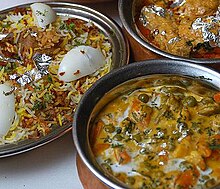Biryani

Biryani, Biriani, Beryani or Beriani is an South Asian dish that comes in set of rice-based foods made with spices, rice (usually basmati) and meat, fish, eggs or vegetables. The name comes from the Persian word beryā(n) which means "fried" or "roasted".[1]
The cooking method of Biryani came from Iran. It was brought to the Indian subcontinent by Iranian travelers and merchants. In India and Pakistan, the recipe of biryani developed to its current form. Local variants of this dish are popular not only in South Asia but also in Bangladesh, Southeast Asia, Arabia, and within various South Asian communities in Western countries.
Ingredients
[change | change source]The spices and condiments used in biryani may include, but are not limited to, ghee, nutmeg, mace, cumin,[2] pepper, cloves,[2] cardamom, cinnamon, bay leaves, coriander, mint leaves, ginger, onions, and garlic. The premium varieties include saffron.[2] For a non-vegetarian biryani, the main ingredient with the spices is the meat—beef, chicken, goat, lamb, fish or shrimp. The dish may be served with dahi chutney or raita, korma, curry, a sour dish of eggplant (brinjal), boiled egg and salad.
Biryani and pullao are different. In biryani the rice (plain or fried) is cooked separately from the thick sauce (curry of meat or vegetables). The curry and the rice are then brought together and layered. This makes a dish with contrasting flavors of rice, sauce and meat or vegetables.
References
[change | change source]Other websites
[change | change source]![]() Media related to Biryani at Wikimedia Commons
Media related to Biryani at Wikimedia Commons
